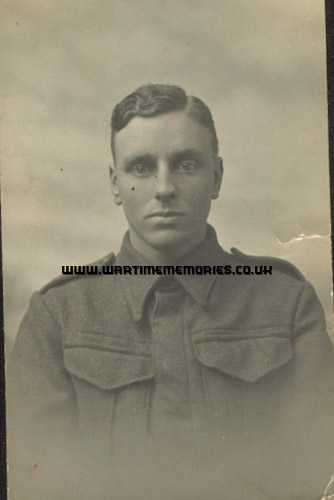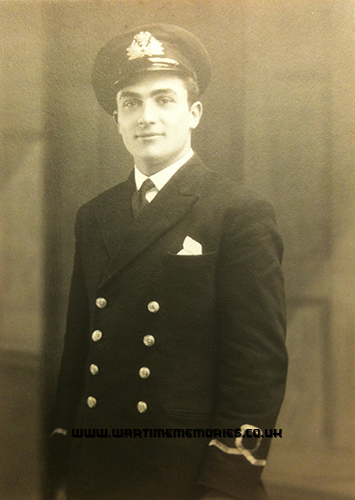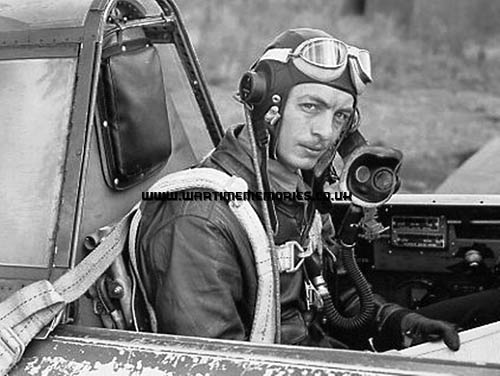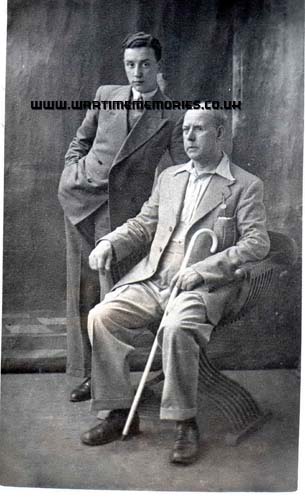Brian Campbell Vickery . Civilian Chemist Royal Ordnance Factory 37 Making explosives
I was in the middle of studying at Oxford University for a degree in chemistry when World War 2 was declared. Oxford became crowded, as the government moved several civil service departments there. Our only direct contact with military matters was watching for firebombs at night on the roofs of laboratories (in fact, Oxford was never bombed). Just before my final exams in 1940, there came the evacuation of our army from Dunkirk, and for some reason troops of exhausted rescued soldiers came tramping through Oxford on their way to camp. Preoccupied by these glimpses of reality, there is little wonder that my exam results were poor!
In the summer of 1941 I finished my research year, and received an official letter: report to the Royal Ordnance Factory 37 near Bridgwater, Somerset, to work there as a 'plant chemist'. The factory was in the countryside, a few miles outside the town. It was just starting up, to make two explosives, tetryl and RDX. I had never been in a factory before, let alone an explosives factory, and the same was true of 95 percent or more of the staff, many drawn from the towns and villages of Somerset. Only a few senior chemists and foremen had any experience. RDX was a new chemical, designed by a government laboratory, and had never been made on an industrial scale. So we all had everything to learn.
I was assigned to the RDX plant. On arrival, I was told to put on overalls. 'Have you ever seen an industrial pump?', I was asked. 'No'. 'So here is a spanner, here is a pump, take it to pieces and see how it works'. My first lesson in industrial chemistry.
The factory made explosives 24 hours a day, 7 days a week, throughout the rest of the war (bar a few grand shutdowns for major maintenance). So there were three shifts of work each day. Apart from the two explosives plants, there were others making acids and other ingredients. Altogether there were employed about 50 plant chemists, a similar number of foremen, and the total workforce approached 3000. Between 1941 and 1945, about 20,000 tonnes of RDX were produced. In a chemical factory, it is the chemicals that do the main work, by interacting between themselves to make new ones. The people have the job of lugging the chemicals from one place to another, putting the right ones together in the right quantities, and watching thermometers and other indicators to see that the process is not getting out of control - a boring but vital job. Because RDX was so new, there was much not known about it, so the factory also had its own laboratory with another substantial group of chemists exploring its behaviour and checking on its quality.
What does a 'plant chemist' do? While the foreman allocates workers to jobs and supervises the work, the chemist is there to see that technically things are going as they should, and to give technical instructions on what to do when they aren't. We had many an emergency to cope with. Once on my shift, the temperature of a reaction vessel started to climb. We increased the flow of cooling water, brought in extra hoses, even stopped the inflow of chemicals into the vessel - all to no effect. The temperature went on climbing. I felt in my guts that something nasty was going to happen, so I got everybody out of the reaction room. The liquid in the vessel boiled, and scalding hot acid was spewed and sprayed about the room. Thank god no-one was caught by it.
RDX itself was a very safe chemical, a white powder. You could hammer it, even burn it without danger of explosion. The big problem for us was the very strong acid used to make it - the liquid acid itself, or even its fumes. From time to time acid tanks were emptied, and we would go inside them to clean them - and often come out gasping and choking from the fumes.
We ate, in the middle of each shift, in a works canteen. Changing shifts and meal times each week, on canteen food, was not very good for the stomach. Every so often I was employed on a 'yield' test. This involved supervising the measurement of the input of all chemicals, and the output of explosive, over a period of 24 hours - working three shifts in a row. The worst feature of this exercise, apart from the lack of sleep, was eating the same canteen meal three times in a day!
From the raw RDX explosive we made two products. If you mixed RDX and TNT together, heated and stirred them, you got a toffee-like material. This was broken up into slabs and shipped out to shell-filling factories. There it could be remelted and poured into shells - they became the 'blockbuster' bombs used by the RAF. On the other hand, if you mixed RDX with the right sort of oil, you got a product like plasticine. This became the famous plastic explosive now known as Semtex, used not only by the Resistance in France but by many a terrorist since.
The manufacture of this plastic explosive gives an interesting picture of the realities of chemical production at that time. The oil was made from three materials: 'mineral jelly' (a petroleum byproduct), chunky sheets of crepe rubber, and slabs of beeswax (the product, we were told, of large African bees). These last two were chopped into small pieces, and heated together in a vat with the jelly and a little lecithin (a vegetable protein). They were rendered down into an oil, and heating was continued until the oil was 'the right viscosity' (stickiness). Viscosity was tested by taking a small sample of the oil on a dipstick, and touching a plate with this to see if it seemed 'sticky enough'. A batch of freshly made RDX was stirred into a large container with water, and heated. A dose of oil was poured in. If you were lucky, granules of RDX coated with the oil were formed, and these could be filtered off through a tap at the bottom of the container. If out of luck, the oil and RDX formed a single glutinous mass that had to be dug out. Oily granules were next loaded into water-jacketed vessels, heated and stirred – the vessels were in fact dough-mixers used in bread-making. Then the 'dough' was forced through heavy rollers. This was continued until the plastic was 'the right plasticity'. Plasticity was measured by taking a sample, cooling it, rolling it into a small sausage, and trying to stretch the sausage to see how quickly it broke. Unusable plastic was too crumbly, and broke too quickly.
At one time, we were getting too many unusable batches of plastic. For each batch of RDX, the works laboratory routinely made an analysis of the distribution of particle sizes. We had the idea that particle size might affect plasticity, and I looked back over our production records to seek some correlation. At first, no success, but then I speculated that the very large particles in a batch of RDX might be aggregates of small particles, that would break down during plastic production, so in the analysis we should add them to the count of small particles. This was successful – poor plasticity seemed to be correlated with an excess of small particles as now counted. We set a threshold value, and in future used for plastic explosive only RDX batches with the amended small-particle content below that threshold (other batches went into RDX-TNT toffee). Now most batches of plastic proved to be usable.
As well as the danger from acid, there were always mechanical accidents, and I was the victim of one. A process in making Semtex was to squeeze the plastic between big spring-loaded rollers. One day a fitter and myself were cleaning the rollers. The start button was on the other side of the machine, and he went round to switch the rollers on to test them. 'Are you clear?' he called. 'Yes', I replied, but I reached to pull out my cleaning rag. The rollers sucked in the rag and me, and took off the top of a thumb - luckily not the whole hand.
I went to Bridgwater hospital. Most of the regular staff had been drafted into military service, and those who remained were not the best. Because of inadequate antiseptics, a swelling crept up my arm, and the nurses desperately put the arm into a heated box to drive out the infection - happily successfully. One night the head (or perhaps only?) surgeon and the matron got drunk together, and at midnight decided to 'do the rounds', waking up the whole hospital.
Apart from working on the plants, men in the factory served in a unit of the Home Guard - and Dad's Army was not too far from the truth. German aircraft did not come near Bridgwater, let alone German troops, so our activities were mainly training for the action that never came, and sleepless nights guarding local bridges. We had one significant engagement. We were training with dummy mortars (no explosive) outside the factory. A shell was accidentally launched towards the factory, sailed in, hit and smashed the main steam-line, and closed down the whole works.
Working daily together on our RDX plant for four years led to close friendships - even though we scattered after the war and few of these friendships were maintained. One man I greatly admired was our senior plant foreman, Geordie Perkins. He was indeed a 'Geordie'. As a youth he had followed his dad into the Durham coal mines, but he soon had enough of it. If he left, it would put his father in a bad light. So they staged a fist-fight in the mine, Geordie shouting that he wanted out, his dad shouting that he would make him stay. The mine superintendent was so disgusted that he sacked Geordie on the spot. For some years he drifted doing navvy work on the roads, but eventually - because he was a very capable organiser - got more responsible work.
I lived in digs in Bridgwater at first, and came into contact with an amateur dramatics group. We had a lot of fun putting on plays for the local populace - probably more fun than the audiences had. In 1944 it was the centenary of the Cooperative movement (started at Rochdale a hundred years before). A playwight wrote a pageant, telling the history of the movement over the century, and every local cooperative society was encouraged to stage it. Printed copies of the play were provided, together with a 'production manual', and gramophone records of music and songs to be played during the show. The Bridgwater co-op decided to have a go, and asked the director of our amateur group to produce the pageant, with me as stage manager.
The characters in the pageant were to be played by those connected with the local co-op - employees or members - so it was indeed an amateur show. There was one problem - it was an historical display, so it needed period costumes. The only source was the theatrical costumiers of London. So I was despatched by train up to the big city to seek out the required outfits. Since co-ops all around the country were doing the same, costumes were in great demand. After a lot of searching, I found a costumier who could provide what we wanted, but rental prices were soaring by then. I had to telephone to Bridgwater for permission to clinch a deal. There was no subscriber dialling in those days, and the telephone system was very overloaded, so I rang the exchange and asked for the number, waiting long for a connection. During the wait, the Germans were sending over their little powered bombs - 'doodlebugs', as we nicknamed them. You would hear their engines chugging, then they would cut off and start to fall, and you waited breathless for the bang. Both the operator and I could hear them and we exchanged comments: 'ooh, that one sounded close'.
Eventually we got our costumes, did our rehearsals, and the big day arrived - a good turnout from local co-op supporters. Though once again it was like Dad's Army, the sight of local characters on stage went down well with the audience. The co-op butcher, due to play some historic role, became gloriously drunk and incapable. We got him into costume, pushed him on stage, told him to wave his arms, and I spoke his words from behind a screen. And that was our pageant.
During the last year of war I moved to the factory hostel, and made new friends. The summer of 1945 was hot, and I spent happy hours with the Irish girl who would later become my wife, cuddling in the sunny fields when we were off work. At last came the day of Victory in Europe. Everyone, of course, went to the pubs to celebrate. In the pub where my girl and I went with English friends, there was a contingent of Irish workers from the factory. They started singing Republican songs, leading up to 'The hanging of Kevin Barry'. At the end, there was a shout: 'That's what the bloody English did to the Irish' and all hell broke loose. My girl and I ran. Thus World War 2 in Europe ended, and an older one broke out again.
|
Sgt. Robert William Vincent . British Army 51st Field Regiment, 203rd Battery Royal Artillery from Whitehaven My father, Billy Vincent was a coal miner (born in 1908) working at the Haig Pit in Whitehaven Cumbria with his best friend Billy Burney of Hilltop Road Whitehaven. Both were members of 203rd Battery, 51st Regiment. Royal Artillery along with my father's brother Edgar Vincent (later of Central Avenue, Whitehaven. All (I believe) served in 203rd Battery between the wars, I guess for the bounty and the annual camp at Hawick, in the Scottish Borders. They were horse drawn Artillery and still wore WW1 type uniform.
My father gained the rank of Serjeant Signaller. On the outbreak of war 1939 they were "Called to the Colours" and my parents were married on the Boxing Day of the that year. When the Germans invaded Norway my father was part of the military response and 203rd Battery was sent to support the Norwegian forces.
The following is dredged up from my childhood memories of stories from my father of his active service and books and research I have done.
The Allied (French and British) Forces landed at various points along the the Norwegian coast, (Narvic and Andalsnes I believe). My father told me that they advanced to the south to support the Norwegian forces but from the first contact with the German forces they were under retreat, due to the terrain and the allies (French & British) being confined to the roads. Whenever they set up a blocking position the Germans had ski troops to by pass them and place them under fire.
After evacuation back to Britain, the 203rd Battery was sent to North Africa where they were involved in driving the Italian Army back from the Egyptian frontier and eventually ended up in the Siege of Tobruk. The 203rd Battery fought in the siege of Tobruk alongside the Australian forces and received a letter of commendation from the Australian commander when both units were withdrawn to Alexandria and replaced with Polish and South African forces.
During the evacuation the ship that my father was on was sunk (torpedoed? Bombed?). We still have my fathers paybook and photos of my mother and sister that were in his pockets when he was rescued which were stuck together due to being immersed in the sea.
Sometime after arriving at Alexandria my father was taken ill and hospitalised and the 51st Field Artillery was sent to India and eventually became Chindits under Orde Wingate and resulting in ill health for many after the war.
My father was drafted into another outfit as he put it and took a voluntary reduction in rank to lance bombardier to remain in the Artillery. Following his return to duty he was back in action until Rommel succeeded in driving the British forces back and finally capturing Tobruk and my father. A letter to my mother from his comrade on that day said that they were out repairing a field telephone line and while returning with some equipment he saw 2 Germans jump out of a trench and take my father prisoner.
He eventually ended up, I believe, in Campo 7 in Italy. When the Allied Forces invaded Italy and Italy capitulated the prisoners were ordered by the Allies to stay in the Italian POW camps until relieved by Allied Forces. Unfortunately the Germans arrived first and my father ended up in Stalag 4b at Muhlberg near Dresden. This would be about 1943 I think. We still have his German dog tags and ID card which state he was a driver. I believe this was a ruse to enable him to get on work parties outside the camp as he used to tell of bartering luxury items like soap, chocolate, milk powder, etc. from Red Cross parcels with the locals for basics like bread, potatoes and vegetables. He remained there until liberated by Russian forces in April 1945 although I believe that they were not released immediately.
My father suffered ill health due to his war service dying at age 59 from arterial sclerosis. I believe this was due to excessive smoking when he was a POW in order to kill hunger pangs, cigarettes were the main currency in the camp.
He also told me that although life was hard for allied POWS it was far worse for the Russian POWS who were separated from the Allies and who didn't have Red Cross parcels and often begged scraps from the other prisoners.
|







